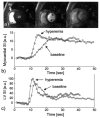Coronary artery calcification and myocardial perfusion in asymptomatic adults: the MESA (Multi-Ethnic Study of Atherosclerosis)
- PMID: 16949496
- PMCID: PMC1853335
- DOI: 10.1016/j.jacc.2006.04.089
Coronary artery calcification and myocardial perfusion in asymptomatic adults: the MESA (Multi-Ethnic Study of Atherosclerosis)
Abstract
Objectives: This study assessed the cross-sectional association between coronary artery calcification (CAC) and myocardial perfusion in an asymptomatic population.
Background: Clinical studies showed that the prevalence of stress-induced ischemia increased with CAC burden among patients with coronary heart disease (CHD). Whether an association between CAC and myocardial perfusion exists in subjects without a history of CHD remains largely unknown.
Methods: A total of 222 men and women, ages 45 to 84 years old and free of CHD diagnosis, in the Minnesota field center of the MESA (Multi-Ethnic Study of Atherosclerosis) were studied. Myocardial blood flow (MBF) was measured using magnetic resonance imaging during rest and adenosine-induced hyperemia. Perfusion reserve was calculated as the ratio of hyperemic to resting MBF. Agatston CAC score was determined from chest multidetector computed tomography.
Results: Mean values of hyperemic MBF and perfusion reserve, but not resting MBF, were monotonically lower across increasing CAC levels. After adjusting for age and gender, odds ratios (95% confidence intervals) of reduced perfusion reserve (<2.5) for subjects with CAC scores of 0, 0.1 to 99.9, 100 to 399, and > or =400 were 1.00 (reference), 2.16 (0.96 to 4.84), 2.81 (1.04 to 7.58), and 4.99 (1.73 to 14.4), respectively. Further adjustment for other coronary risk factors did not substantially modify the association. However, the inverse association between perfusion reserve and CAC attenuated with advancing age (p for interaction < 0.05).
Conclusions: Coronary vasodilatory response was associated inversely with the presence and severity of CAC in asymptomatic adults. Myocardial perfusion could be impaired by or manifest the progression to subclinical coronary atherosclerosis in the absence of clinical CHD.
Figures


Comment in
-
Coronary artery calcification and myocardial perfusion: kissing cousins or distant relatives?J Am Coll Cardiol. 2006 Sep 5;48(5):1027-8. doi: 10.1016/j.jacc.2006.06.017. Epub 2006 Aug 17. J Am Coll Cardiol. 2006. PMID: 16949497 No abstract available.
References
-
- Kragel AH, Reddy SG, Wittes JT, Roberts WC. Morphometric analysis of the composition of atherosclerotic plaques in the four major epicardial coronary arteries in acute myocardial infarction and in sudden coronary death. Circulation. 1989;80:1747–56. - PubMed
-
- Simons DB, Schwartz RS, Edwards WD, Sheedy PF, Breen JF, Rumberger JA. Noninvasive definition of anatomic coronary artery disease by ultrafast computed tomographic scanning: a quantitative pathologic comparison study. J Am Coll Cardiol. 1992;20:1118–26. - PubMed
-
- Rumberger JA, Simons DB, Fitzpatrick LA, Sheedy PF, Schwartz RS. Coronary artery calcium area by electron-beam computed tomography and coronary atherosclerotic plaque area. A histopathologic correlative study. Circulation. 1995;92:2157–62. - PubMed
-
- Tanenbaum SR, Kondos GT, Veselik KE, Prendergast MR, Brundage BH, Chomka EV. Detection of calcific deposits in coronary arteries by ultrafast computed tomography and correlation with angiography. Am J Cardiol. 1989;63:870–2. - PubMed
-
- Budoff MJ, Georgiou D, Brody A, et al. Ultrafast computed tomography as a diagnostic modality in the detection of coronary artery disease: a multicenter study. Circulation. 1996;93:898–904. - PubMed
Publication types
MeSH terms
Grants and funding
- N01-HC-95162/HC/NHLBI NIH HHS/United States
- R01 HL065580-02/HL/NHLBI NIH HHS/United States
- N01 HC095169/HL/NHLBI NIH HHS/United States
- N01-HC-95159/HC/NHLBI NIH HHS/United States
- N01-HC-95165/HC/NHLBI NIH HHS/United States
- N01 HC095159/HL/NHLBI NIH HHS/United States
- R01 HL065580/HL/NHLBI NIH HHS/United States
- N01-HC-95160/HC/NHLBI NIH HHS/United States
- N01-HC-95167/HC/NHLBI NIH HHS/United States
- N01-HC-95163/HC/NHLBI NIH HHS/United States
- N01-HC-95168/HC/NHLBI NIH HHS/United States
- R01 HL065580-03/HL/NHLBI NIH HHS/United States
- N01-HC-95169/HC/NHLBI NIH HHS/United States
- N01-HC-95164/HC/NHLBI NIH HHS/United States
- N01-HC-95161/HC/NHLBI NIH HHS/United States
- R01 HL-65580/HL/NHLBI NIH HHS/United States
- R01 HL065580-01/HL/NHLBI NIH HHS/United States
- N01-HC-95166/HC/NHLBI NIH HHS/United States
LinkOut - more resources
Full Text Sources
Medical
Molecular Biology Databases

